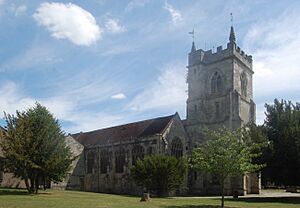Salisbury Arts Centre facts for kids
The Salisbury Arts Centre is a cool place in Salisbury, Wiltshire, England. It's run by a group called Wiltshire Creative. This group is a charity that helps people in the community enjoy and get involved in different types of art.
The Arts Centre hosts many educational and community events. Lots of these events are free! They also take part in bigger events around the city, like the Larmer Tree Festival.
The centre is located inside an old church called St Edmund's Church. It's on Bedwin Street in the middle of Salisbury. The main area where shows happen can fit 164 people sitting down or 400 people standing up. There's also a smaller studio called the White Room that seats 60. Plus, it has a media space, a craft room, a pottery studio, an art exhibition area, a café, a bar, and offices for staff.
Contents
How the Arts Centre Started
From Church to Arts Hub
In July 1974, a big event called the Salisbury Festival of the Arts was held in the church. This festival is now known as the Salisbury International Arts Festival. It featured classical music and an exhibition of batik paintings. The church building had been declared "redundant" earlier that year. This means it was no longer needed as a church. During the festival, visitors were asked for ideas on how to use the building.
In 1975, the church's committee agreed to let it be used as an arts venue. A group called St Edmunds Arts Trust was created. Volunteers started organizing art shows for local artists. They also held workshops for different crafts.
Growing and Developing
The Arts Centre kept growing over the next few years. Between 1979 and 1981, a famous artist named Henry Moore loaned one of his sculptures. It was called Reclining Figure (Time Life 1953). This large sculpture was placed right outside the main entrance.
By the 1990s, the Arts Centre faced a challenge. It was in danger of closing because of money cuts. But people from the community quickly started a "Save Our Arts Centre" campaign. Their efforts worked! A new plan for funding was accepted, and the Arts Centre stayed open.
Modern Upgrades and New Beginnings
Around 2003, the Arts Centre raised money for a big renovation project. They collected £4.2 million for these improvements. The project made the heating better and added new flat floors. It also created different spaces inside the main building. The toilets were improved, and new technical equipment was installed. A new part was added to the north side of the old church. This new section provided offices and workshops.
The Salisbury Arts Centre reopened in 2005 with many new events.
Joining Forces with Other Arts Groups
In 2018, the Arts Centre joined together with the Salisbury Playhouse and the Salisbury International Arts Festival. They all became one big organization called Wiltshire Creative. The St Edmunds Arts Trust combined with the Playhouse's charity. This new combined charity was also renamed Wiltshire Creative.
What Happens at the Arts Centre
Supporting the Community
Salisbury Arts Centre often plans events for people with disabilities. They work with groups that support disability arts. The centre also works with many other community groups. They offer free events, like the yearly Family Fiesta. They also have regular Live Lunches, which are popular.
Artists and Performances
The Arts Centre helps many artists who work there. One example is Mirka Golden-Hann, a ceramic artist. She studies how colors and glazes work on pottery. The centre's gallery also has many different art exhibitions.
The Arts Centre hosts concerts too, like the regular Altar Club band nights. They also have film nights and other cultural events. Some famous entertainers performed at Salisbury Arts Centre early in their careers. For example, the Manic Street Preachers played there in November 1990.
In 2015, the Centre was in the news. This happened after local people protested when the city suddenly stopped giving them money.
The History of St Edmund's Church
Founding a Collegiate Church
A special kind of church, called a collegiate church, was started on this site in 1269. It was founded by Walter de la Wyle, who was a Bishop. The church was named after Saint Edmund of Abingdon. He used to be the Archbishop of Canterbury and became a saint in 1246.
At first, the plan was to have a leader (called a provost) and thirteen priests. However, the money the college received was not enough to support so many people. They finally had the full number of priests in the middle of the next century. This happened after they received money from places like Whiteparish, Winterbourne Earls, and Winterborne St Martin. In the 15th century, the college had money problems again. Like other colleges, it was given to Henry VIII in the 1540s.
Changes to the Church Building
The church building from the 13th century was rebuilt in the early 15th century. It was shaped like a cross, with a tower in the middle. In 1653, the tower fell down. This badly damaged the part of the church to its west. The tower was rebuilt, but the damaged part was taken down. The 15th-century chancel (the part of the church near the altar) was then used as the main part of the church.
A small chancel was added to the east end in the 1840s. Then, from 1865 to 1867, the church was restored by Sir George Gilbert Scott. This work included making the chancel larger.
The church building was given a special status in 1952. It was listed as Grade II* listed, meaning it's a very important historic building. In 1974, the building was declared "redundant." This meant it was no longer used as a church. Its parish (the area it served) was then combined with that of St Thomas in the city centre.


